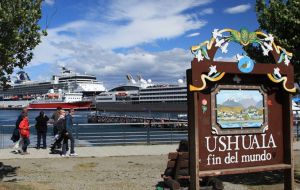MercoPress. South Atlantic News Agency
Growing number of Chinese tourists visit Antarctica, but with carbon credits
 Chinese tourists fly to Ushuaia where they will board a cruise for a tour of the Antarctic Peninsula, or combined with the Falklands and South Georgia
Chinese tourists fly to Ushuaia where they will board a cruise for a tour of the Antarctic Peninsula, or combined with the Falklands and South Georgia  Chinese tourists travel on organized cruises subject to strict rules. Cruise ships are registered with IAATO and operate under the terms of the Antarctic Treaty
Chinese tourists travel on organized cruises subject to strict rules. Cruise ships are registered with IAATO and operate under the terms of the Antarctic Treaty  Ten travel agencies signed to help tourists buy carbon credits to offset the five tons of carbon dioxide emissions that result from one person’s trip.
Ten travel agencies signed to help tourists buy carbon credits to offset the five tons of carbon dioxide emissions that result from one person’s trip. The number of Chinese visitors to the Antarctic Peninsula is growing rapidly, adding to concerns over the fragile ecosystem. It’s almost a three-week trip and will cost at least 100,000 Yuan (US$15,000), and before a foot is set on frozen land, special boots are needed to walk over a sponge mat soaked in disinfectant. Besides this season Chinese tourists will have to purchase carbon credits to offset emissions.
Since trips were first approved for Chinese tourists in 2007, about 13,000 of them have made the journey, with over 5000 setting foot on the Antarctic Peninsula in the 2016-17 tourist season alone. They were among over 40,000 visitors that season, with Americans making up the largest single group.
Typically, Chinese tourists will fly to Ushuaia in Argentina where they will then board a cruise ship for a tour of the Antarctic Peninsula, or this combined with the Falkland Islands and South Georgia in the southern Atlantic Ocean.
Gao Jie, director of overseas trips at Shanghai China Travel Service, said that a broader range of Chinese tourists are now making the trip.
“Initially in 2008 it was a small number of business founders and photographers. Now you see owners of small and medium businesses, artists, amateur photographers, teachers, retirees, students – a trip to Antarctica is a lot more achievable than it used to be.”
The number of tourists to Antarctica has more than doubled from about 20,000 in 2010-11 to about 45,000 in 2016-17. This compares to just over 6,700 visitors in 1992. And following the approval for Chinese tourists in 2007, they have grown from just over 3% of visitors in 2010-11 to almost 12% this season.
But as the number of tourists grows, there is growing concern that the Antarctic environment will be damaged, with an official from the Chinese foreign ministry saying that tourism to Antarctica should not be expanded for this very reason.
Chinese tourists travel on organized cruises (only one couple has made an independent trip), and are subject to strict rules. Cruise ships are registered with the International Association of Antarctica Tour Operators (IAATO) and operate under the terms of the Antarctic Treaty. IAATO’s guide for tourists explains how to avoid disturbing animal and plant life, protected areas, and scientific activities.
Some countries where Antarctic tourism is more established have their own specific rules for visiting, alongside those set out in the Antarctic Treaty. The US forbids carrying rubbish, plants or animals, and breaches can be dealt with under civil or criminal law. Japan requires visitors to register with its environmental authorities. As yet, China has no such rules in place.
Although there are no Chinese government policies regulating tourist behavior in the Polar Regions, there is some consensus within the industry on the need to promote responsible tourism.
Ten travel agencies signed up to one such initiative in May at an Antarctic Treaty meeting held in Beijing. This will see the companies help tourists buy carbon credits to offset the five tons of carbon dioxide emissions that result from one person’s trip. This is equivalent to approximately two return flights from Beijing to London.
The initiative includes Gao Jie’s agency and the Chinese agent for an international cruise ship operator. Together, the signatories account for over half of all Chinese tourists going to Antarctica.
There was no national carbon market in China when Gao Jie first promoted the idea of carbon-neutral tourism so the company bought 1,000 tons of carbon credits from the Shanghai Environment and Energy Exchange instead. (chinadialogue).




Top Comments
Disclaimer & comment rulesCommenting for this story is now closed.
If you have a Facebook account, become a fan and comment on our Facebook Page!